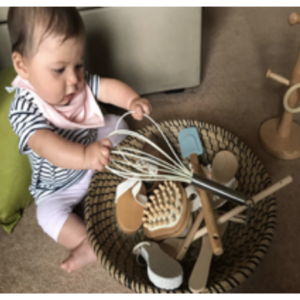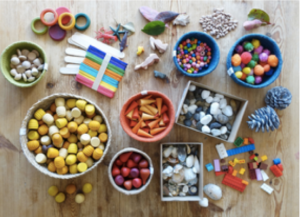The third teacher
After the teacher and the parents, children learn from their environment.
The concept of the environment as the third teacher is prominent in Montessori and Reggio Emilia approaches to learning. The ways in which your homeschool space is designed play an essential role in shaping how children learn.
Heavily decorated or too many materials displayed in your learning space may become overwhelming and actually distract your child from school work.
Consider a minimalist design and only display materials that your child needs for the day or week. Rotate the materials and resources as you see fit!

Another idea is to create separate spaces for learning. You might have noticed this design in school classrooms. Gauge your homeschool space for different energy levels, and play on these cues to support engagement in learning.
Create an Engaging Homeschool Space «Ateliers» (Workshop Spaces)
This idea is inspired by the Reggio Emilia pedagogy. Ateliers encourage experimentation, intuition and creativity. Limit sitting time and encourage your child to learn using their whole body! Find time for sensory exploration, body breaks, and play-based learning.
- Bring learning experiences outdoors
- DIY art studio (“art” as in fine arts, music, dance, theatre, etc.)
- STEM corners (activities based on science, technology, engineering and mathematics)

Self regulation spaces
Create space for times when children need calm and emotional support. This area can include bean bags, pillows and blankets. Consider these quiet activities to support children’s self-regulation:
- Reading books
- Drawing/colouring (you can include colouring books or blank sheets of paper to engage children’s creative side!)
- Listening to music

Self regulation spaces

Loose parts are natural, synthetic or upcycled materials that can easily be found in your own home or backyard. These materials are open-ended; children can move, manipulate, control, and change them within their play and learning. Contrary to games, there are neither rules nor winning or losing in this type of play. This is why Loose Parts capture children’s curiosity, give freedom to their imagination, and motivate learning.
Can you spot the learning concepts that you can tie in with Loose Parts at home?

Les textures:
- Lisse (smooth)
- Robuste (rugged)
- Doux (soft)
- Dur (hard)
- Sablonneux (sandy)
- Panier en osier (wicker basket)

Les conceptes STIM:
- Compter (to count)
- Motifs (patterns)
- Bâtir (to build)
- Expérimenter (to experiment)
- Essai et erreur (trial and error)
- Découverte (discovery)

Peux-tu nommer… (Can you name…):
- Les couleurs
- Les formes
- Les matériaux

